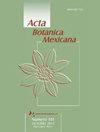墨西哥普埃布拉高原上菜豆科植物的花卉访客:农业管理和花卉颜色的重要性
IF 0.8
4区 生物学
Q4 PLANT SCIENCES
引用次数: 1
摘要
背景与目的:Phaseolus coccineus是一种异种植物,具有花色变异,繁殖依赖于传粉者。该物种有两种种植方法:一种是不使用农药来控制杂草和害虫(传统管理),另一种是使用农药来控制杂草和害虫(技术管理)。目前还没有研究评价农业管理制度和花色对该树种访花者的影响;因此,我们的目标是分析这些因素如何影响球菌访花者的多样性和频率。方法:以两种不同管理制度下栽培的2个地方品种(白花和红花)为研究对象。在花期进行8天的同步观测,量化花的访客和访问的数量。计算物种丰富度和有效物种数,有效物种数作为物种多样性的衡量标准。采用卡方检验,进行对应分析,并构建秩丰度曲线。关键结果:共记录到42种形态种,分6目。优势种为蜜蜂和白颊兔。在传统管理下,白花和红花的到访次数分别为1613次和1105次。在技术管理下,这些值分别为1427和815。不同管理系统之间存在一致的统计差异,但花的颜色没有差异。在白花中,传统管理的多样性是技术管理的两倍。在红色的花朵中,这种差异是1.26倍。结论:葡萄球菌访花的多样性和频率受到传统农业管理的青睐,表明推广该类型种植的可取性。在研究条件下,花的颜色对物种的丰富度没有影响,对访问频率也没有明显的影响。本文章由计算机程序翻译,如有差异,请以英文原文为准。
Floral visitors in the crop Phaseolus coccineus (Fabaceae) on the Altiplano of Puebla, Mexico: importance of agricultural management and flower color
Background and Aims: Phaseolus coccineus is an allogamous plant, with variation in flower color, and reproduction that depends on pollinators. The species is cultivated under two approaches: one in which agrochemicals are not used to control weeds and pests (traditional management) and another in which they are (technified management). No studies have evaluated the influence of agricultural management system and flower color on the floral visitors of this species; our objective was therefore to analyze how these factors affect the diversity and frequency of the floral visitors of P. coccineus. Methods: A study was conducted with two landraces of P. coccineus (white-flowered and red-flowered), cultivated under two different management systems. Simultaneous observations were conducted for a period of eight days during the peak of flowering, quantifying the number of floral visitors and visits. Species richness and the effective number of species were calculated, the latter was used as a measure of diversity. Chi-square tests were applied, a correspondence analysis performed, and rank abundance curves constructed. Key results: Forty-two morphospecies were recorded, grouped into six orders. Apis mellifera and Hylocharis leucotis were the predominant species. The numbers of visits recorded under traditional management were 1613 and 1105 in white and red flowers, respectively. Under the technified management, these values were 1427 and 815, respectively. There were consistent statistical differences between management systems, but not for flower color. In the white flowers, the traditional management was twice more diverse than the technified management. In the red flowers, this difference was 1.26 times. Conclusions: The diversity and frequency of floral visitors of P. coccineus are favored by the traditional agricultural management, demonstrating the desirability of promoting this type of cultivation. Under the conditions studied, flower color did not influence the species richness or demonstrate any defined tendencies on the frequency of visits.
求助全文
通过发布文献求助,成功后即可免费获取论文全文。
去求助
来源期刊

Acta Botanica Mexicana
生物-植物科学
CiteScore
1.60
自引率
12.50%
发文量
52
审稿时长
>12 weeks
期刊介绍:
Acta Botanica Mexicana da a conocer trabajos originales e inéditos en todas las áreas de la botánica, incluyendo florística, taxonomía, taxones nuevos para la ciencia, ecología, etnobotánica, paleontología, evolución, conservación, etc. Está dirigida a botánicos mexicanos y extranjeros que aporten información en estas áreas del conocimiento, particularmente con plantas nativas del continente americano. Hasta 2018 apareció cuatro veces al año con una periodicidad estricta en la primera semana de enero, abril, julio y octubre; a partir de 2019 se publica de manera continua, sin periodicidad preestablecida, en formato electrónico y de forma gratuita.
 求助内容:
求助内容: 应助结果提醒方式:
应助结果提醒方式:


